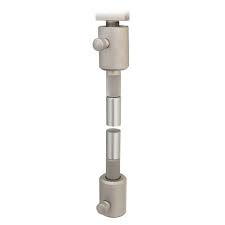The ASTM C633 test method is used to determine the adhesion or cohesive strength of thermal spray materials by subjecting them to a tensile force perpendicular to the surface.
The substrate fixtures used to spray the coating are typically cylinders made of the same metal that will be used as the coating substrate in actual service. If your application does
not specify a substrate, the ASTM C633 standard specifies the use of SAE 1018 or 1020 steel. A similar but uncoated fixture is then bonded to the coating surface using a suitable adhesive.
The adhesive should not be the "weakest link" but should be at least as strong as the minimum adhesion or cohesive strength required for the coating.
To ensure that the direction of the applied force is perpendicular to the coating surface, ASTM C633 specifies that these substrate cylinders be attached to the test frame using
self-aligning load fixtures. The assembly is pulled at a constant rate between 0.030 in/min and 0.050 in/min until failure. The maximum force is then normalized over the cross-sectional
area to give the adhesion or cohesive strength of the thermal spray. If failure occurs entirely at the coating-substrate interface, the result is called adhesion strength. If failure occurs
within the coating, the result is referred to as cohesive strength.
Challenges of testing to this standard are:
Data rate for capturing maximum peaks
Fixtures that conform to the standard
Lixian Solution:
Data rate for capturing maximum peaks - Lixian’s range of tensile test frames enable data capture up to 2.5 kHz to ensure all rapidly changing test events are captured.
Too low a bandwidth may make the system “sluggish” and result in lost peaks and therefore adhesion or cohesion values.
Fixtures that conform to the standard - Lixian’s fixtures for testing to ASTM C633 offer self-aligning ends that natively accommodate load cells and base adapters on
electromechanical test systems. In addition to this, we find it very useful to incorporate axial slack couplings into the design of the loading device as it can significantly
reduce setup time. Test blocks of different sizes can be made to test specimens across the entire size range allowed by the standard.
It is necessary to review ASTM C633-2011 in order to fully understand the test setup, procedure and results requirements.



